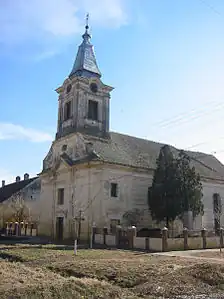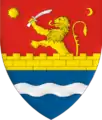Iecea Mare | |
|---|---|
 The Roman Catholic church in 2006 | |
 Location in Timiș County | |
 Iecea Mare Location in Romania | |
| Coordinates: 45°51′N 20°53′E / 45.850°N 20.883°E | |
| Country | Romania |
| County | Timiș |
| Government | |
| • Mayor (2020–2024) | Liviu Tomulea[1] (PSD) |
| Area | 35.31 km2 (13.63 sq mi) |
| Population (2021-12-01)[3] | 3,111 |
| • Density | 88/km2 (230/sq mi) |
| Time zone | EET/EEST (UTC+2/+3) |
| Postal code | 307091 |
| Vehicle reg. | TM |
| Website | www |
Iecea Mare (Hungarian: Nagyjécsa; German: Großjetscha; Serbian: Велика Јеча, romanized: Velika Ječa) is a commune in Timiș County, Romania. It is composed of a single village, Iecea Mare, and was part of the commune of Cărpiniș until 2004, when it was split off.
History
The first recorded mention of a settlement named Uche dates from 1317. This settlement existed throughout the Middle Ages, as shown by numerous medieval documents reminiscent of Wche (1417), Ewcze (1467), Eqche (1479).[4] After the expulsion of the Turks from Banat, one cannot speak of a settlement, but there was the Jetsa estate, as shown by Count Mercy's map of 1723.[4]
The present-day village was founded in 1767 by Councilor Johann Wilhelm Edler von Hildebrand, who brought German settlers from Lorraine, Luxembourg, Trier, Bavaria, etc., for whom he built 202 houses.[5] The Germans named some areas of the village and the streets after their origin. Thus, there were Österreich ("Austria") and Haszrundel areas and Luxembourg, Trier, Bakowa, Kirchen, Nei, Periam, Lefelstadt, Yeger, Schwarzwald ("Black Forest") and Letzte ("last arrived") streets. In 1779 the name Gross Jetscha ("Great Iecea") also appears, and the locality is assigned to Torontál County.[4] In 1836, there was a cholera epidemic that killed about 100 locals.
Demographics
Iecea Mare had a population of 2,231 inhabitants at the 2011 census, down 4% from the 2002 census. Most inhabitants are Romanians (84.18%), with a minority of Roma (5.24%). For 9.73% of the population, ethnicity is unknown.[6] By religion, most inhabitants are Orthodox (74.9%), but there are also minorities of Pentecostals (5.87%), Roman Catholics (5.06%), Adventists (2.24%) and Greek Catholics (1.88%). For 9.73% of the population, religious affiliation is unknown.[7]
| Census[8] | Ethnic composition | ||||
|---|---|---|---|---|---|
| Year | Population | Romanians | Hungarians | Germans | Roma |
| 1880 | 3,297 | 24 | 21 | 3,193 | – |
| 1890 | 3,431 | 30 | 20 | 3,329 | – |
| 1900 | 3,099 | 38 | 68 | 2,923 | 68 |
| 1910 | 2,535 | 34 | 48 | 2,360 | 81 |
| 1920 | 2,549 | 47 | 5 | 2,412 | – |
| 1930 | 2,289 | 38 | 11 | 2,107 | 130 |
| 1941 | 2,355 | 59 | 69 | 2,051 | – |
| 1956 | 3,056 | – | – | – | – |
| 1966 | 3,173 | 1,573 | 21 | 1,411 | 161 |
| 1977 | 2,986 | 1,610 | 23 | 1,162 | 187 |
| 1992 | 2,297 | 1,907 | 25 | 115 | 243 |
| 2002 | 2,315 | 2,008 | 24 | 37 | 239 |
| 2011 | 2,231 | 1,878 | 9 | 8 | 117 |
References
- ↑ "Results of the 2020 local elections". Central Electoral Bureau. Retrieved 16 June 2021.
- ↑ "Primăria Iecea Mare". Ghidul Primăriilor.
- ↑ "Populaţia rezidentă după grupa de vârstă, pe județe și municipii, orașe, comune, la 1 decembrie 2021" (XLS). National Institute of Statistics.
- 1 2 3 Szabó, M. Attila (2003). Erdély, Bánság és Partium történeti és közigazgatási helységnévtára. Miercurea Ciuc: Pro-Print Kiadó.
- ↑ Lotreanu, Ioan (1935). Monografia Banatului. Timișoara: Institutul de Arte Grafice „Țara”.
- 1 2 "Tab8. Populația stabilă după etnie – județe, municipii, orașe, comune". Institutul Național de Statistică. Archived from the original on 2016-01-18. Retrieved 2021-10-23.
- 1 2 "Tab13. Populația stabilă după religie – județe, municipii, orașe, comune". Institutul Național de Statistică. Archived from the original on 2020-08-07. Retrieved 2021-10-23.
- ↑ Varga, E. Árpád. "Temes megye településeinek etnikai (anyanyelvi/nemzetiségi) adatai 1880-2002" (PDF).
